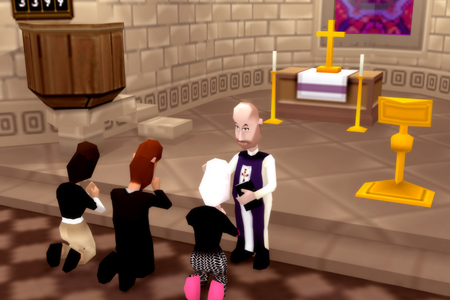| |
 |
 |
 |
| The story so far... |
 |
| You're currently on our features and projects pages, with material ranging from the satirical to the theological. For more features, click here. |
| |
|
|
| Holy communion... in six tweets |
 |
 |
 |
| When Revd Tim Ross, a Methodist minister from Worthing, announced in July that he was going to run a communion service on Twitter, the social networking service, the reaction was, to put it mildly, a bit mixed. |
 |
On the one hand, Tim Ross, a newcomer to Twitter who was already tweeting his contemporary version of the Lord's Prayer, suddenly found himself with a growing online congregation (currently just over 1,200 followers), ready to tweet and be tweeted unto in this latest initiative in online religion.
On the other hand were bloggers such as Zwinglius Redivivus, who posted, in a somewhat Reformation vein, "You, good sir, are defacing communion in a way that not even Satan could manage."
More significantly, the Methodist Church gave Tim Ross a call and pressured him not to go ahead with the service. This was apparently not for any specific theological problem, but because the Church does not yet have a fully formed policy to cover the issue.
However, a comment from Revd Ken Howcroft, Assistant Secretary of the Methodist Council, suggests which way the wind might be blowing in Methodist Church House. He insisted that "holy communion is a corporate celebration to be in an embodied community where people relate to each other in the same time, place and space."
Revd Ross is not the first person to attempt communion on the Net. LifeChurch.tv, a multiple-campus church in the United States which broadcasts "Online Experiences" via streamed video in real time, includes communion for those sitting at their computers. Instructions posted on Facebook include: "In order to prepare, you'll want to have these elements on hand: 1) Bread – small piece of bread, cracker, etc. 2) Small glass of something to drink – grape juice, wine, Kool-Aid, etc."
Flamingo Road Church, in Florida, is another early adopter of online sacraments, offering online baptism conducted via webcam, in addition to other less surprising ministries. "The goal is to not let people at home feel like they're watching what's happening, but they're part of it. They're participating," says Brian Vasil, the church's Internet pastor.
BEFORE THE ARRIVAL of the Internet, older media such as radio and TV were cautious about how religion should be delivered on the airwaves. One story has it that when the BBC first proposed broadcasting worship on the wireless, the Dean of St Paul's objected because the services might be heard by "men in pubs wearing hats".
But by the 1980s, something that looked rather like communion was being delivered every Sunday morning on BBC One's "This is the Day". The programme was broadcast live from ordinary homes, and the set included flowers, a candle, a Bible and a bread roll – but no wine. The "viewing congregation" (as the production team called the audience) were invited to bring their own bread and eat it as an act of fellowship, at the same time as the bread was broken and eaten on TV. There was no prayer of consecration.
Geoffrey Marshall Taylor, who worked on the programme, says the producers were "at pains to be clear that this was a non-eucharistic service. However, central to it was linking a virtual community of viewers, whom we saw as participants, not voyeurs." Key to this experience was the live transmission, which meant the bread was shared in real time.
It was precisely this detail – sharing in real time – which gave Tim Ross the idea for his Twitter Communion, although the theological caution of the TV age was replaced by theological adventure, facilitated by the free and open channel of Twitter. Says Tim Ross: "What I love about Twitter is the instantaneous contact it gives you with your followers. It gave me the idea that we could do a live communion service for believers around the world, sharing together the bread and wine as the one Body of Christ."
Theological support for the idea has come from Baptist systematic theologian Paul Fiddes. In a short paper published last year, he explored whether avatars (characters appearing onscreen in computer worlds) could receive the bread and wine of the eucharist within their world, and this be an indirect means of grace for the person controlling the avatar.
He argued that it was possible, partly because God is present in a virtual world, and also because of the surprisingly intimate relationship between the person and their avatar. As an example of that latter point, one member of Church of Fools, the 3D experiment in online church which ran in 2004, observed, "Typing the command to cross myself and then seeing myself do it was as real and meaningful as doing so with my physical hand."
Revd Dr Michael Moynagh, a missioner for Fresh Expressions, is also positive. While conceding that different eucharistic theologies will produce widely different responses to the idea of virtual communion, he asks, "If the presence of the Spirit makes the sacrament effective, is there a need for worshippers to be physically in the same place? Can the Spirit not be powerfully at work through communion even though the community is scattered?"
DESPITE THESE BEGINNINGS of a theological foundation, and the temptation to experiment which online technology brings, the UK's major online churches remain wary of embracing any form of e-eucharist.
Revd Pam Smith is Priest in Charge of i-church, an online community based on Benedictine principles and launched by the Diocese of Oxford in 2004. She notes that the church would need specific permission from their Bishop to introduce a new format for the sacraments, but adds, "I think it's an issue that will keep coming back. Some people who find it hard to get to an offline church have found Christ present in their online Christian community and naturally want to express that through communion."
The Anglican Cathedral in the online world of Second Life is also subject to a this-worldly church in the form of the Bishop of Guildford. He is currently writing a paper on the theological aspects of Second Life services, but for the time being, no sacraments are celebrated and the community would only do so with permission.
The Bishop speculated in a Church Times article in 2008 that an online sacrament could possibly be seen as "spiritual communion", similar to the non-sacramental service followed by servicemen and women when they are not able to make their communion. However, this promising idea has not been taken up.
Since the avatars in Second Life are extremely varied (you can appear in that world as a mermaid, a wolf or a hairy Hell's Angel, for example), the leadership of the Anglican Cathedral has sometimes debated the vexed question of "whether a dragon could lead evensong".
This might lead to some interesting "angels dancing on a pin" discussions about the bestiary permitted to preside at holy communion. But actually, it is a serious issue. The way Second Life works presents some significant problems for Christian worship there, and this could partly explain the delay in finding solutions.
Meanwhile, in the rather less colourful world of St Pixels, an ecumenical community with no external hierarchy to satisfy, there is little demand from the grassroots members for BYOB&W services alongside their other chatroom-based worship. Mark Howe, a member of the management team, comments: "I think the one-sentence summary is that doing anything still looks too divisive to happen as a mainstream event."
So between sensible caution, risk-aversion and the shutting down of Twitter Communion, is it possible to receive the eucharist online from any church in the UK? The answer lies with Luss Parish Church, on the bonny banks of Loch Lomond. This Church of Scotland community sees 150 weddings per year, due to the picturesque and patriotic location, and has been streaming marriage services on the Web for the past six years so that family and friends abroad can "be there" too.
When they added their regular church services to the stream, they found up to 10,000 people joining them online at a time. Dane Sherrard, the minister, says, "Quite a number of people who join us every week for our service were, off their own bat, gathering together their own elements of bread and wine and sharing with us at communion time. What we are really doing is sharing our service with those who are unable to get to a traditional church to worship."
Only a few years ago, the Internet was a strange place you entered and exited via a dial-up connection. But now, as it becomes increasingly integrated into our daily lives, with Facebook friends, BBC iPlayer, supermarkets online and 1001 apps for your mobile phone, the virtual world is getting less virtual and more real by the day. In fact, the virtual was never unreal; it's just taken us half a generation to get used to it.
And with that change, a growing number of people who can't or won't go to churches made of bricks – through illness or old age, or because of past bad experience of church, are choosing to worship online instead. Whether the historic denominations are going to allow these places of worship to break bread and drink wine together is not a small matter. At heart, it's a question of whether they are recognised as genuine churches at all.
This article was first published in a shorter form in the Church Times. |
|
|
|
|
|
|


